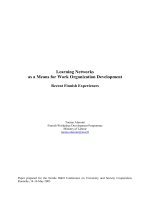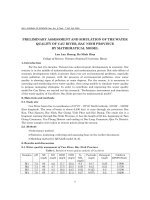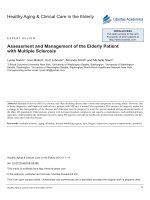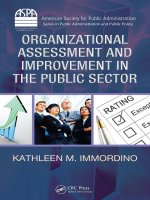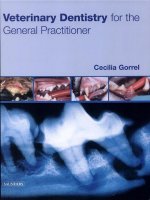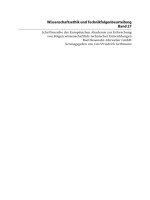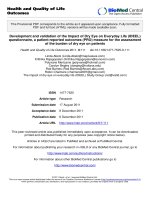Assessment and diagnosis for organization development - powerful tools and perspectives for the OD practitioner
Bạn đang xem bản rút gọn của tài liệu. Xem và tải ngay bản đầy đủ của tài liệu tại đây (2.19 MB, 216 trang )
Assessment and Diagnosis
for Organization Development
Assessment and Diagnosis
for Organization Development
Powerful Tools and Perspectives
for the OD Practitioner
Edited by
William J. Rothwell, Angela L.M. Stopper,
and Jennifer L. Myers
CRC Press
Taylor & Francis Group
6000 Broken Sound Parkway NW, Suite 300
Boca Raton, FL 33487-2742
© 2017 by Taylor & Francis Group, LLC
CRC Press is an imprint of Taylor & Francis Group, an Informa business
No claim to original U.S. Government works
Printed on acid-free paper
International Standard Book Number-13: 978-1-1380-3334-4 (Hardback)
This book contains information obtained from authentic and highly regarded sources. Reasonable efforts have been made
to publish reliable data and information, but the author and publisher cannot assume responsibility for the validity of all
materials or the consequences of their use. The authors and publishers have attempted to trace the copyright holders of all
material reproduced in this publication and apologize to copyright holders if permission to publish in this form has not been
obtained. If any copyright material has not been acknowledged please write and let us know so we may rectify in any future
reprint.
Except as permitted under U.S. Copyright Law, no part of this book may be reprinted, reproduced, transmitted, or utilized in
any form by any electronic, mechanical, or other means, now known or hereafter invented, including photocopying, microfilming, and recording, or in any information storage or retrieval system, without written permission from the publishers.
For permission to photocopy or use material electronically from this work, please access www.copyright.com (http://www.
copyright.com/) or contact the Copyright Clearance Center, Inc. (CCC), 222 Rosewood Drive, Danvers, MA 01923, 978-7508400. CCC is a not-for-profit organization that provides licenses and registration for a variety of users. For organizations that
have been granted a photocopy license by the CCC, a separate system of payment has been arranged.
Trademark Notice: Product or corporate names may be trademarks or registered trademarks, and are used only for identification and explanation without intent to infringe.
Library of Congress Cataloging‑in‑Publication Data
Names: Rothwell, William J., 1951- author. | Stopper, Angela L. M., author. |
Myers, Jennifer L., author.
Title: Assessment and diagnosis for organization development : powerful tools
and perspectives for the OD practitioner / William J. Rothwell, Angela
L.M. Stopper, Jennifer L. Myers.
Description: Boca Raton, FL : CRC Press, 2017.
Identifiers: LCCN 2016035602 | ISBN 9781138033344 (pbk. : alk. paper)
Subjects: LCSH: Organizational change. | Organizational
effectiveness--Evaluation.
Classification: LCC HD58.8 .R6845 2017 | DDC 658.4/06--dc23
LC record available at />Visit the Taylor & Francis Web site at
and the CRC Press Web site at
William J. Rothwell dedicates this book to his wife,
Marcelina V. Rothwell. She is the wind beneath his wings.
Angela L.M. Stopper dedicates this book to her unbelievably supportive,
flexible, and always-in-her-corner husband, Benjamin C. Stopper, the State
College Tribe, and her Chapter 8 Crew. “You all make me a better person.”
Jennifer L. Myers dedicates this book to her niece, Nevaeh and her nephew,
Leonardo. Always follow your dreams and use your talents to make the
world we live in a better place. I love you both more than you know.
Contents
Preface........................................................................................................ix
Acknowledgments ..................................................................................xiii
About the Editors..................................................................................... xv
About the Authors ..................................................................................xix
Advance Organizer .................................................................................xxi
1 Introduction and Overview of Diagnosis and Assessment for
Organization Development ..........................................................1
WILLIAM J. ROTHWELL
2 Diagnosing and Assessing Organization Development
Effectiveness ..............................................................................11
ANGELA L.M. STOPPER AND JENNIFER L. MYERS
3 Diagnostic Models following Open Systems ..............................29
HYUNG JOON YOON
4 Diagnostic Models Addressing Environmental Forces and
Organizational Readiness ..........................................................55
HYUNG JOON YOON
5 Planning for Assessment and Feedback for Organization
Development ..............................................................................79
JENNIFER L. MYERS AND LINDSAY WEISSBERG
6 Collecting and Analyzing Data for Organization
Development ...................................................................... 95
ANGELA L.M. STOPPER AND JENNIFER L. MYERS
7 Feeding Back Data and Action Planning for Organization
Development ............................................................................129
ANGELA L.M. STOPPER AND JULIE D. STAGGS
vii
viii ◾
Contents
8 Challenges and Their Related Opportunities in Diagnosis
and Assessment for Organization Development ...................... 153
ANGELA L.M. STOPPER
9 Conclusion and Future Directions of Diagnosis and
Assessment for Organization Development ............................. 175
WILLIAM J. ROTHWELL
Index ..............................................................................................185
Preface
This book comes from a real-world perspective and provides insights from
those practitioners and consultants practicing organization development
(OD) assessment and diagnosis today. OD assessment and diagnosis is
not based on a medical approach that begins with diagnosis and ends
with prescriptions or therapy. Instead, OD engages clients to build change
leadership initiatives customized to meet client-defined problems and
implement client-defined solutions. OD is not about a consultant telling a
client company what to do. Instead, it is about an OD professional guiding
client companies on their journeys toward the best end point for their
particular situation. This book will address that journey.
To do so, the theory and foundational principles of OD are covered.
However, much of this book provides applications to the real world of OD
consulting practice. Although this book is grounded in sound academic
theory, the chapters are laid out in a practitioner-focused way, containing
real-world themed vignettes and tools that individuals can use to help
guide organizational assessment and diagnosis efforts in their own or client
organizations.
The Audience for this Book
This book is for current or aspiring OD consultants and managers who
wish to apply facilitative approaches to change. It addresses organizational
assessment and organizational diagnosis for those who work inside
organizations (that is, internal OD consultants) and those who work outside
organizations (that is, external consultants). It should also interest others,
such as human resource professionals and operating managers, who have
reason to manage change in organizational settings.
ix
x
◾
Preface
Overview of the Contents
This book comprises nine chapters.
Chapter 1 introduces the concepts and overall theory related to diagnosis
and assessment for OD. It briefly describes the difference between OD and
performance consulting. This chapter sets the stage for the remainder of
the book, engaging the reader and inciting their interest in the topics and
learning to come.
Chapter 2 discusses the methods that can be used in an OD assessment
and diagnosis from the organizational-, group- and individual levels
and provides some tools that practitioners can use at each of the levels.
Central to this is the link between an organization’s strategic plan and the
assessment. This chapter includes two vignettes, one focused on diagnosing
with a clearly understood mission, vision, and strategic plan in place and
the other focused on diagnosing without an articulated and written mission,
vision, and strategic plan. This chapter also includes some discussion to
help OD practitioners clarify his/her role with clients and with themselves.
It ends by spending time engaging the reader to think about how to
measure success when performing assessment at different levels, as well as
a worksheet to engage practitioners in creating a strong self-assessment of
their OD intervention in order to promote continued growth and learning.
Chapters 3 and 4 build on the discussions from previous chapters
by describing diagnostic models from which OD practitioners select or
synthesize data. Diagnostic models are very important in organizational
assessment and diagnosis. Chapter 3 starts with a comparison between
open and closed systems and then goes into detail regarding the key
features of open systems. Open systems are discussed first, because most
diagnostic models are based on open systems. Guidelines for identifying
and applying open systems models are discussed, and numerous real-world
themed vignettes are included, focusing on (1) identifying and synthesizing
an open systems model, (2) the application of an open systems model, and
(3) the OD effectiveness model. This chapter closes with examples of data
collection tools employing open systems models.
Because diagnostic methods are built on models, this chapter serves
as a foundation for subsequent chapters on planning, gathering, and
analyzing data.
Chapter 4 helps OD practitioners understand models that address
environmental forces and organizational readiness. The topics include
force field analysis and practical guidelines for assessment. In addition,
Preface
◾ xi
this chapter explores the use of models to address the readiness of an
organization (that is, Likert System 1–4, High Performance Programming
Model) and practical guidelines for models for highly ready organizations
(that is, Appreciative Inquiry and The Great Place to Work Model). This
chapter includes numerous vignettes focused on (1) addressing the
readiness of an organization, (2) the application of Appreciative Inquiry,
and (3) the application of the Great Place to Work Model. This chapter
ends with tools pulled from each vignette, including questions to ask, tips
for following up on the results, and key takeaways for OD intervention
development.
Chapter 5 introduces the importance of dedicating time and resources for
planning assessment and feedback. It introduces key concepts and literature
to help the reader understand organizational assessment and feedback and
provides a model that has proven to be a valuable tool for assessment,
planning for feedback, and organization improvement. This chapter includes
a real-world themed vignette and provides a tool to help practitioners plan
for successful assessment and feedback.
Chapter 6 specifically focuses on the tools and techniques needed for
collecting and analyzing data in organizational assessment and diagnosis.
In this digital age, we all know that you can collect a plethora of data on
any number of topics. But what makes useful data (information) different
from noise is its meaningfulness related to the current situation. This
chapter will explore the importance of individualized data collection to
make the information gathered meaningful and actionable to your team.
It will also provide insights into the numerous tools that can be used for
data collection, describing the positives and challenges with each and
giving practitioners all of the information they need to design a solid
data collection plan. This chapter includes a real-world vignette focused
on increasing employee participation in OD engagements, discussion on
real time and simulated observational data collections, and tools to help
practitioners write strong interview and survey questions. It ends with
a checklist to help practitioners craft a strong behavioral observation
worksheet.
Chapter 7 describes how to provide data collected during organizational
assessment to the client. Key to this point is for the practitioner to have good
facilitation skills so the organization’s perspective and point of view emerge
in a collaborative discussion about the data, the gaps, and the strategic
outcome desired. This discussion is followed by another one on the next
step in assessment, diagnosis, and action planning. This chapter discusses
xii
◾
Preface
action planning where a change model involving multiple stakeholders,
planning, and execution of the plan is created.
This chapter focuses on tools to use to communicate the diagnosis and
assessment in a way that involves the client and provides insights while not
falling into prescriptions like performance consulting. The chapter outlines
this process, gives examples of reports, and gives tips on facilitating a
feedback session to move to a collaborative plan of action. It closes with a
Feedback and Action Planning Worksheet, designed to allow practitioners a
quick reference guide to use when designing a feedback session with clients,
as well as links to Project Management and other tools needed for success in
this step of the OD assessment and diagnosis process.
Chapter 8 challenges readers to think about the ways in which the
organizational assessment and diagnosis process can go wrong. Four
real-world themed vignettes are included that dramatize how mistakes can
be made at each of the start gates (planning, collecting and analyzing data,
feeding back data, and action planning). Steps to avoid the challenges are
then discussed. This chapter ends with a Challenges Quick Reference Tool,
outlining the chapter information in bullet format and the steps used to
overcome the said challenges.
Chapter 9 concludes this book. What future challenges are likely to
affect assessment and diagnosis for OD in the twenty-first century? How
can organizational leaders prepare for these challenges? This chapter
describes possible future trends and offers ideas on how to prepare for
these challenges. This chapter ends with a worksheet for meeting the future
challenges in OD assessment and diagnosis, providing practitioners with a
tool that they can use to plan for meeting the stated challenges.
Acknowledgments
The editors thank the many people who helped make this book possible.
That includes chapter authors as well as those who looked over the
manuscript to improve it.
Of special note, we thank Kathleen E. Wolfhope for her early
contributions to this project and Aileen G. Zaballero for her intrepid Project
Management skills.
xiii
About the Editors
William J. Rothwell, PhD, SPHR, SHRM-SCP, CPLP Fellow, RODC
(see www.rothwellandassociates.com) leads a graduate emphasis in
organization development at the master’s and PhD levels at Penn State
University. He had 20 years of full-time work experience in HR in both
government and business before he became a consultant and university
professor 18 years ago. Best known for his extensive and high-profile
consulting work in succession planning, organization development, and
talent management with numerous organizations in the United States
and around the world, William J. Rothwell is a frequent speaker or
keynoter at conferences and seminars around the world. He has authored,
coauthored, edited, or coedited more than 300 books, book chapters,
and articles. His most recent publications are Organization Development
in Practice (ODNETWORK, 2016), Mastering the Instructional Design
Practice (Wiley, 2016, 5th ed.), Practicing Organization Development (Wiley,
2015, 4th ed.), Effective Succession Planning (Amacom, 2015, 5th ed.), The
Leader’s Daily Role in Talent Management (McGraw-Hill, 2015), Career
Planning and Succession Management (Praeger, 2015), Organization
Development Fundamentals: Managing Strategic Change (ATD Press,
2015), The Competency Toolkit (HRD Press, 2015, 2nd ed., 2nd vol.),
Creating Engaged Employees: It’s Worth the Investment (ATD Press, 2014),
Optimizing Talent in the Federal Workforce (Management Concepts, 2014),
Performance Consulting (Wiley, 2014), the ASTD Competency Study: The
Training and Development Profession Redefined (ASTD, 2013), Becoming
an Effective Mentoring Leader: Proven Strategies for Building Excellence in
Your Organization (McGraw-Hill, 2013), Talent Management: A Step-byStep Action-Oriented Approach Based on Best Practice (HRD Press, 2012),
the edited three-volume Encyclopedia of Human Resource Management
xv
xvi
◾
About the Editors
(Wiley, 2012), Lean But Agile: Rethink Workforce Planning and Gain a True
Competitive Advantage (Amacom, 2012), and Invaluable Knowledge: Securing
Your Company’s Technical Expertise-Recruiting and Retaining Top Talent,
Transferring Technical Knowledge, Engaging High Performers (Amacom, 2011).
Angela L.M. Stopper, PhD, is the director of program innovations and
executive education at the UC Davis Graduate School of Management where
she oversees the development and delivery of innovative management and
leadership development programming for the school. In addition to her work
at UC Davis, Dr. Stopper is also an adjunct assistant professor of education at
Penn State, where she has developed and is teaching a course for the master
of professional studies in organization development and change. Over her
career, Dr. Stopper has worked in numerous client-facing positions at Penn
State in the Outreach and Online Education Departments and the Penn State
Smeal College of Business. Dr. Stopper’s current research focus is global
talent development. Working with the Association for Talent Development,
the research team is investigating trends and challenges, and how formal,
informal, and social learning play in this area. Dr. Stopper is the author
and coauthor of multiple publications and presentations focused on global
talent development, online education, service marketing, change leadership,
and strategic visioning and leadership. Her most recent publications include
Association for Talent Development: Building a Talent Development Structure
without Borders (2015, Alexandria, VA: Author, Product Code: 791504-WP),
and “Measuring and Addressing Talent Gaps Globally” (Global HRD, 32[1505],
1–18) with W. J. Rothwell, A. L. M. Stopper, and A. G. Zaballero. Her past
research projects include numerous internal and external corporate needs
assessments, workshop development and facilitation in the United States,
Saudi Arabia, and China, consulting projects focusing on executive coaching,
and research papers in the areas of learning preferences of a generationally
diverse workforce, cross-generational collaboration, and using distance
learning in noncredit adult education programs. Dr. Stopper holds a BS in
marketing and international business, an MS in workforce education and
development, and a PhD in workforce education and development with a
concentration in human resources and organization development, all from
the Pennsylvania State University.
About the Editors
◾
xvii
Jennifer L. Myers, PhD, is a practitioner in the field of human resource
development and organization development for the public sector. She is also
graduate faculty at Penn State, teaching an organizational diagnosis course in
the master of professional studies in organization development and change.
Dr. Myers holds a PhD from the Pennsylvania State University in workforce
education and development, specializing in human resource development
and organization development. She received her master’s degree from
Boston University, Massachusetts, and is also a graduate of the Federal Law
enforcement Training Center (FLETC), Georgia. Prior to transitioning to her
current position, she served as an instructor for the Professional Personnel
Development Center (PPDC) at Penn State. Dr. Myers is also an Operation
Enduring Freedom (OEF) veteran and is a recipient of numerous service
awards, some of which include the Air Force Expeditionary Service Ribbon
with Gold Bolder, Meritorious Unit Award, and multiple Commendation
Medals. Her current research interests are employee engagement, organization
development, and strategic planning. Dr. Myers is the author and coauthor
of multiple publications and presentations focused on engagement, diversity,
healthcare, and career development. Dr. Myers’ most recent publications
include the following: Zaballero, A. G., and Myers, J. L. 2014. Engaging the
best people. In W. Rothwell, A. G. Zaballero, and J. G. Park (Eds.), Optimizing
Talent in the Federal Workforce. New York: Management Concepts Press.
Baumgardner, C. Z., and Myers, J. L. 2014. Creating an engaged culture. In
W. J. Rothwell (Ed.), Creating Engaged Employees: It’s Worth the Investment.
Alexandria, VA: ASTD. Wolfehope, K., and Myers, J. 2014. Leadership and
the effects on employee engagement, Journal of Knowledge and Human
Resource Management, 6(13). Alzahmi, R. A., and Myers, J. L. 2013. Identifying
performance gaps through needs assessment. In W. J. Rothwell (Ed.),
Performance Consulting: Applying Performance Improvement in Human
Resource Development (pp. 342–344). San Francisco, CA: John Wiley & Sons.
Imroz, S. M., and Myers, J. L. 2013. Application of SWOT Analysis. In W.
J. Rothwell (Ed.), Performance Consulting: Applying Performance Improvement
in Human Resource Development (pp. 305–307). San Francisco, CA: John
Wiley & Sons.
About the Authors
Hyung Joon Yoon, PhD, is currently an assistant professor of human
and organizational learning at the George Washington University (GWU),
Washington, DC. Prior to joining GWU, he worked as an assistant professor
and program coordinator for the Human Resource Development Program
at Al Akhawayn University in Ifrane, Morocco. He also served as graduate
faculty at Penn State, teaching an organizational diagnosis course in the
master of professional studies in organization development and change.
He holds a PhD in workforce education and development from Penn
State and has gained multinational experiences in countries such as the
United States, South Korea, and Morocco as a researcher practitioner.
Dr. Yoon was bestowed with the Individual Greatness Award (Franklin
Covey Greatness Award) in recognition of the creation of measurable
change in an organization in 2006. He has presented his research findings
at international and national conferences more than 30 times in seven
countries. He has developed or codeveloped career development models
and assessment tools through research, including the Hope-Centered
Model of Career Development (HCMCD), Hope-Centered Career Inventory
(HCCI), the Human Agency Based Individual Transformation (HABIT)
model, and the Assessment of Human Agency (AHA). He is certified as a
Senior Professional in Human Resource (SPHR), and Career Development
Facilitator Master Trainer. He serves the National Career Development
Association (NCDA) as trustee-at-large (2016–2019).
Julie D. Staggs is an associate client partner in the Global Education Practice
of Korn Ferry Hay Group, based in the firm’s Atlanta, Georgia office. She
is an experienced higher education professional who has worked both for
and with higher education for more than 25 years. From admissions and
marketing to curriculum development/delivery and talent management, she
xix
xx
◾
About the Authors
has assisted institutions in reaching their strategic goals. Her engagements
have included working with various universities in strategic planning;
culture/org design; inclusion practices; competency modeling; new program
planning, development, and launch; marketing strategy; and evaluation. She
has directed all project phases, including research, planning, hiring, training,
implementation, and evaluation. Previously, she consulted for Fortune 100
companies in the areas of corporate training, innovation, and strategic
planning. Her consulting at Corporate Executive Boards (CEB) focused
on innovation and strategic partnering besides teaching in the Corporate
Leadership Council’s (CLC) Leadership Academies. Her combination of
higher education and corporate experience provides a broad perspective
for each project. These combined areas of expertise enable her to develop
and deliver customized solutions for institutions. Earlier in her career, she
worked with Adecco as a placement specialist in Washington, DC, with a
focus on placing recent college graduates. As a member of Korn Ferry’s
Global Education practice, she works with institutions around the globe
to design and implement leadership development strategies and programs
across the institution with students, staff, and administration. She received her
bachelor’s degree from Converse College, South Carolina, in music theory and
religion and her executive masters of business administration degree, with a
concentration in leadership, from University of Georgia. She is working on
her doctorate of education in higher education management at the University
of Georgia’s Institute for Higher Education. She also serves on the Board of
Trustees for Converse College.
Lindsay Weissberg, JD, is a practitioner in workforce development for the
federal government. She holds a juris doctor (2009) and a master of public
health (2010) from the University of Pittsburgh, Pennsylvania. She graduated
with distinction from her juris doctor program, receiving the Excellence in
Health Law and the Order of the Barristers awards. While a student, she
was the executive editor of the Pittsburgh Journal of Environmental and
Public Health Law and coauthored articles related to the intersection of the
law and public health priorities. Prior to graduate school, she worked in
the international affairs and public policy arena in Washington, DC. She
graduated cum laude from George Washington University, Washington, DC,
in 2003 with a bachelor of arts in international affairs and minors in Spanish
and political science. Her current professional interests relate to employee
engagement and retention, workplace diversity, supervisor development, and
strategic planning.
Advance Organizer
William J. Rothwell
Complete the following Organizer before you read this book. Use it as a
diagnostic tool to help you determine what you most need to know about
assessing and diagnosing organizations—and where you can find it in this
book fast.
The Organizer
Directions
Read each item in the Organizer below. Circle a true (T), a not applicable
(N/A), or false (F) in the left column opposite each item. Spend about
10 minutes on the Organizer. Be honest! Think of assessing and diagnosing
OD as you would like it to be—not what some expert says it is. When you
finish, score and interpret the results using the instructions appearing at the
end of the Organizer. Then be prepared to share your responses with others
you know to help you think about what you most want to learn about
assessing and diagnosing organizations. If you would like to learn more
about one item in the Organizer, refer to the number in the right column to
find the chapter in this book in which the subject is discussed.
xxi
xxii
◾
Advance Organizer
Circle Your
Response for
Each Time
Below
OD Consultants Should
Chapter in the
Book in Which
Each Topic is
Covered
T
N/A
F
Be able to explain the difference between
organizational assessment and diagnosis.
1
T
N/A
F
Be able to explain the difference between
organizational assessment and diagnosis as
conducted by OD practitioners and as
conducted by performance consultants.
1
T
N/A
F
List organizational assessment/diagnostic
models as roadmaps to guide the process.
2
T
N/A
F
Apply an open systems approach to
organizational assessment and diagnosis in OD.
3
T
N/A
F
Apply force field analysis in organizational
assessment and diagnosis in OD.
4
T
N/A
F
Apply a model that has proven to be a valuable
tool for assessment, planning for feedback,
and organization improvement.
5
T
N/A
F
Use tools and techniques needed for collecting
and analyzing data collected for
organizational assessment and diagnosis.
6
T
N/A
F
Feedback data collected during organizational
assessment to the client.
7
T
N/A
F
Think about (and avoid) ways that the
organizational assessment and diagnosis
process can go wrong.
8
T
N/A
F
Plan for 10 predictions about the future of
organizational assessment and diagnosis in OD.
9
Total
Scoring and Interpreting the Organizer
Give yourself 1 point for each T and a 0 for each F or N/A listed above. Total
the points from the T column and place the sum in the box opposite to the
word Total in the Organizer. Then interpret your score as follows:
Advance Organizer ◾
xxiii
Score
10–9
Congratulations! Give yourself a grade of A. You may be doing an effective
job of organizational assessment and diagnosis from an OD perspective.
8–7
Give yourself a grade of B. You are doing many things right in
organizational assessment and diagnosis from an OD perspective. But
room remains for improvement. Focus your attention on those.
6–5
Give yourself a grade of C. You are muddling through. You should focus on
improving how you carry out organizational assessment and diagnosis
using an OD perspective.
4–3
Give yourself a grade of D. You are below average in organizational
assessment and diagnosis from an OD perspective. Act to improve it!
2–0
Give yourself a grade of F. You are failing in your approach to organizational
assessment and diagnosis. Take immediate action to improve it!
